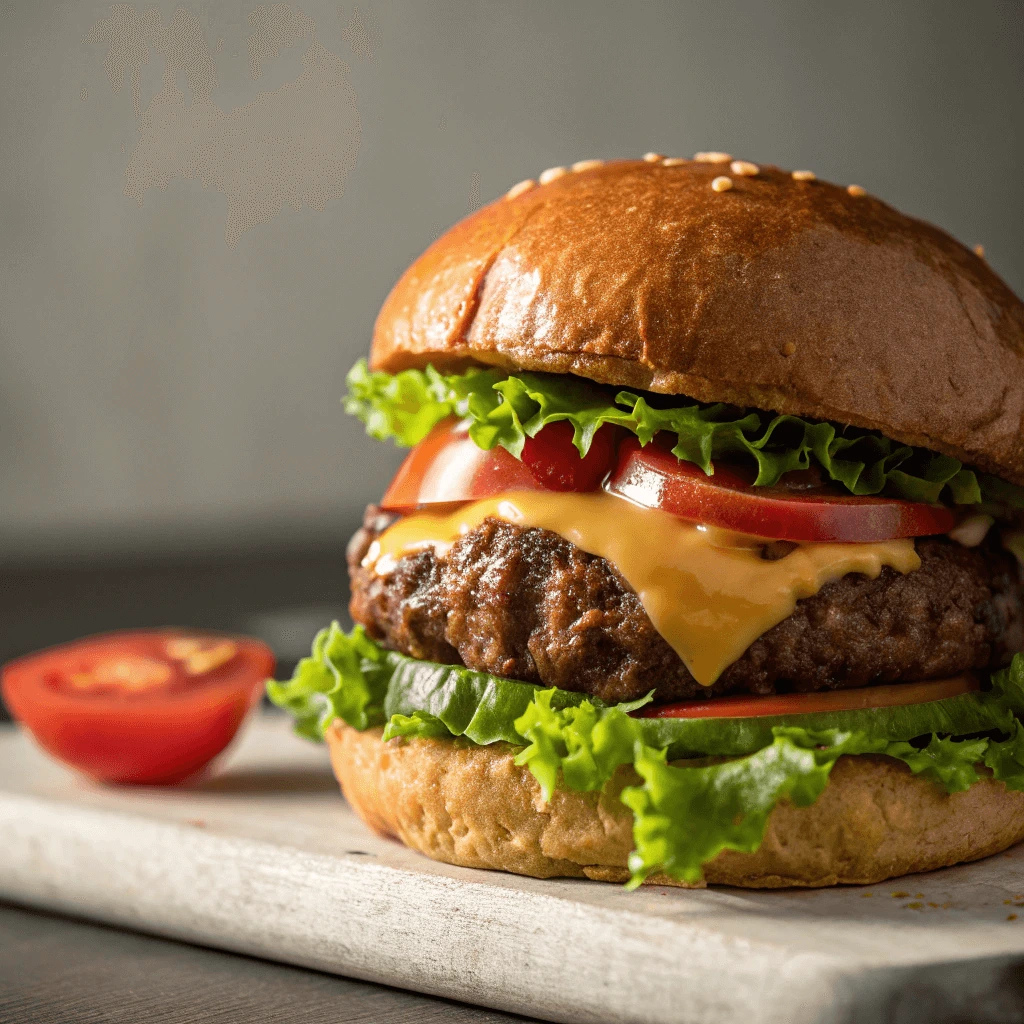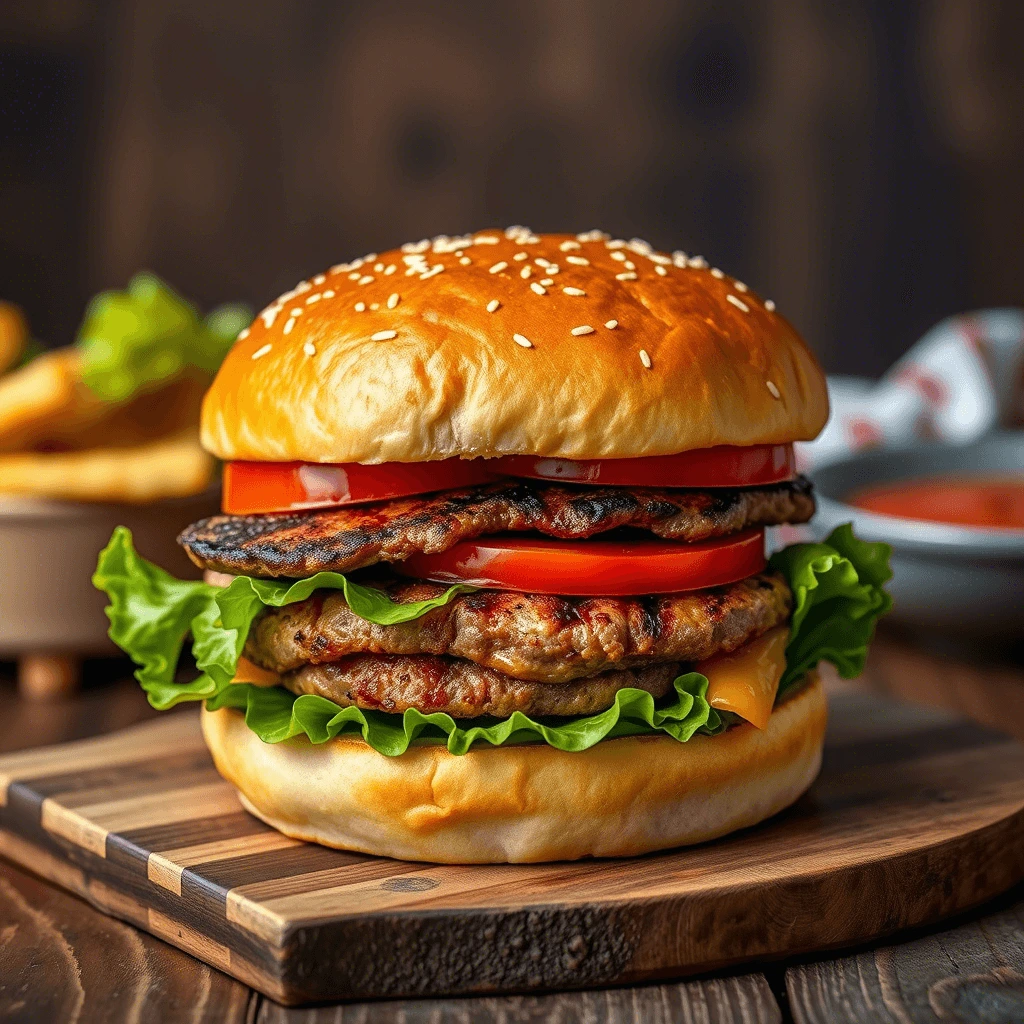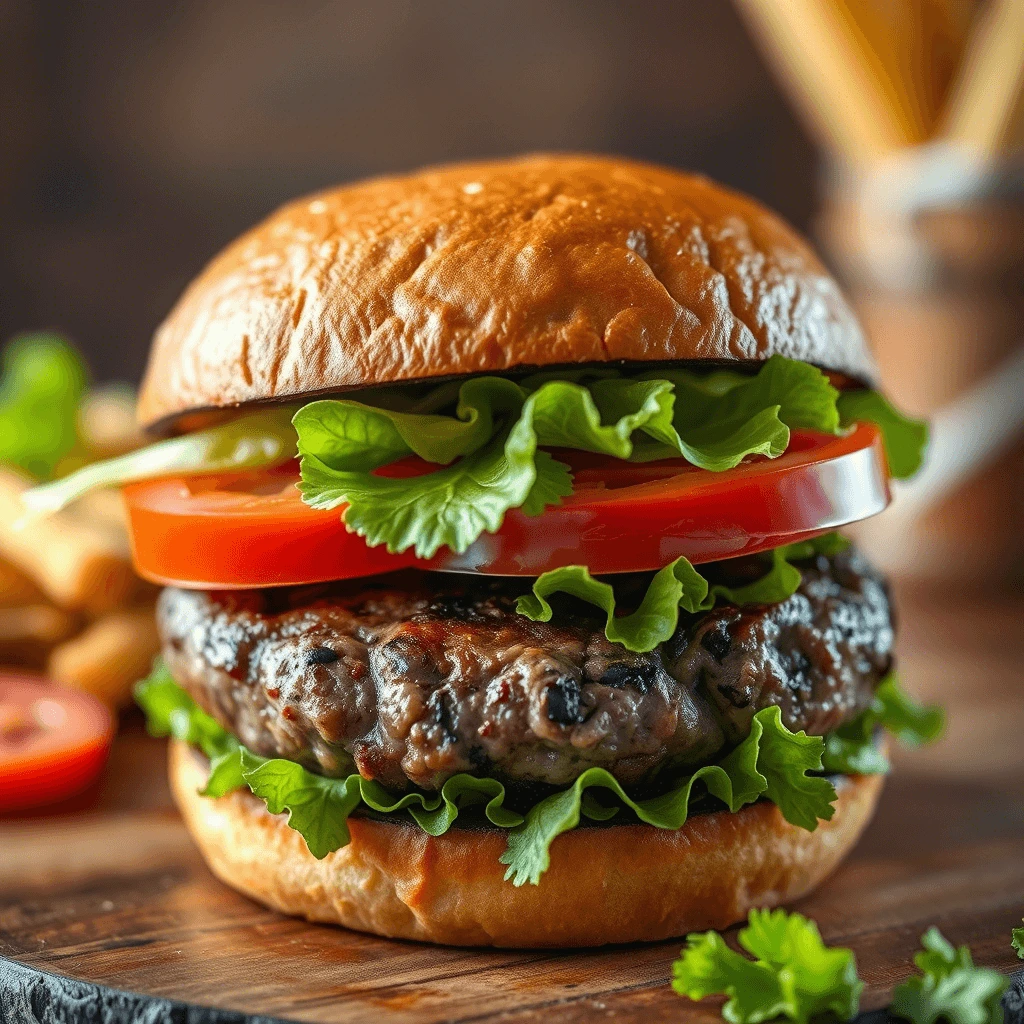If you’re looking to level up your burger game, it’s time to step away from basic beef patties and embrace the bold, juicy flavors of a wild burger. Whether you’re working with venison, elk, or bison, wild game brings a rich, savory depth that most restaurant-style burgers just can’t match. In this post, you’ll learn exactly how to make a wild burger at home that’s not only healthier and more flavorful but also rivals (or beats) anything you’d order at a gourmet burger joint. From choosing the right meat to perfecting your seasoning and toppings, we’ve got everything you need to craft the ultimate wild burger from scratch.
Why Choose a Wild Burger Over Store-Bought Beef?
Health Benefits of Wild Game Meat
One of the biggest reasons health-conscious food lovers are turning to wild burgers is the exceptional nutritional value of wild game meat. Unlike store-bought beef, which is often high in saturated fats and raised with hormones or antibiotics, wild meats like venison, elk, and bison are naturally lean, clean, and protein-packed.
1. Leaner Cuts, Fewer Calories
Wild game meat is significantly leaner than traditional beef, meaning fewer calories and less saturated fat per serving. For example, venison contains about half the fat of beef, making it an excellent option for those watching their weight or managing cholesterol levels. This leanness gives your wild burger a nutritional edge without sacrificing flavor.
2. High in Protein and Essential Nutrients
Wild meats are rich in high-quality protein, iron, zinc, and B vitamins—especially vitamin B12, which supports energy and brain function. Bison and elk are especially good sources of omega-3 fatty acids, which are beneficial for heart health. Including wild game in your diet can support muscle repair, immune function, and overall vitality.
3. No Hormones, No Antibiotics
Most wild game comes from animals that roam free in natural environments, grazing on wild plants. That means your wild burger is typically free of added hormones, antibiotics, and grain-based feed—offering a more natural, wholesome protein source than conventionally raised meats.
Flavor Profile That Beats Restaurant Burgers
When it comes to burgers, flavor is everything—and a wild burger delivers a bold, distinctive taste that mass-produced restaurant burgers just can’t compete with. Wild game meats like venison, elk, and bison offer complex, rich flavors that elevate your burger into something truly special.
1. Rich, Earthy Taste You Can’t Fake
Unlike the mild and sometimes bland flavor of store-bought ground beef, wild game meat brings a naturally earthy, robust profile. Venison has a slightly sweet, woodsy flavor; elk is mild yet rich; and bison offers a clean, slightly sweet beef-like taste with a deeper umami punch. These meats have character—each bite of a wild burger is layered with depth you just won’t get in a typical fast-food patty.
2. Flavor That Reflects Nature
Wild game animals live off native grasses, herbs, and wild plants, which influences the flavor of the meat in the best way possible. This natural diet infuses the meat with subtle herbal and mineral notes, giving your wild burger a terroir-inspired taste—similar to how wine or cheese flavor varies by region. It’s a culinary experience that connects you directly to nature.
3. Pairs Perfectly with Bold Seasonings
Because wild meat is naturally flavorful, it stands up well to strong herbs and spices like smoked paprika, fresh thyme, garlic, and black pepper. Unlike bland burgers that rely on condiments for taste, a wild burger shines with just a touch of seasoning—allowing the meat’s quality to take center stage. This makes it easy to craft a burger that tastes gourmet without needing an overload of sauces or fancy toppings.
Sustainable and Ethical Meat Option
Another powerful reason to choose a wild burger over conventional beef is the environmental and ethical advantage. Wild game meats like venison, elk, and bison often come from more sustainable sources, making them a smart choice for eco-conscious eaters who care about where their food comes from.
1. Lower Environmental Impact
Traditional livestock farming—especially for beef—requires massive amounts of water, feed, land, and energy, and it’s one of the leading contributors to greenhouse gas emissions. Wild game, on the other hand, is often naturally managed by local ecosystems and requires no feedlots, antibiotics, or grain-based agriculture. Opting for a wild burger helps reduce your environmental footprint by supporting low-impact, naturally regenerative food sources.
2. Ethical Sourcing and Wildlife Management
In many regions, wild game is harvested through regulated and sustainable hunting practices, which help maintain healthy animal populations and prevent overgrazing. This type of wildlife management is often led by conservation experts who ensure that ecosystems remain balanced. By choosing wild meat from ethical hunters or verified sources, you’re supporting responsible practices that value animal welfare and habitat conservation.
3. Supporting Local and Small-Scale Producers
Much of the wild meat available on the market comes from small, local farms or licensed hunters—rather than industrial agriculture. This means your wild burger is more likely to be traceable, humanely harvested, and part of a transparent food chain. Many consumers find this reassuring, knowing that their food comes from producers who prioritize sustainability and respect for nature.

Ingredients & Tools for the Ultimate Wild Burger
Choosing the Right Game Meat (Venison, Elk, or Bison)
The foundation of any great wild burger lies in choosing the right type of game meat. Each option—venison, elk, and bison—has its own unique flavor, texture, and fat content. Understanding their differences will help you decide which meat best suits your taste preferences and cooking method.
1. Venison: Lean and Earthy
Venison (typically from deer) is one of the most popular wild meats for burgers. It’s very lean—usually with less than 5% fat—and has a slightly earthy, gamey flavor that pairs well with bold herbs and spices. Because it’s so lean, mixing it with a bit of fat (like beef tallow or bacon) is a great way to keep your patties juicy. Venison is ideal for those who enjoy a deeply savory, natural-tasting burger.
2. Elk: Mild Yet Rich in Flavor
Elk is a favorite among those new to wild game because it has a milder, sweeter flavor than venison, with a rich, beef-like texture. It’s also very lean but a bit more forgiving when cooking, making it easier to get a juicy burger without added fat. Elk works well with classic burger seasonings or more gourmet additions like caramelized onions and aged cheddar.
3. Bison: Clean, Beef-Like Taste with a Twist
Bison is one of the most accessible wild meats in the U.S. and Canada and is often farm-raised under ethical, free-range conditions. It has a clean, slightly sweet flavor that’s similar to beef but with a deeper, more satisfying taste. Bison has more natural fat than venison or elk, so it tends to stay juicy on the grill or stovetop. It’s perfect for those who want a familiar yet elevated burger experience.
Flavor-Boosting Seasonings and Toppings
One of the best things about making your own wild burger at home is the freedom to elevate it with creative, bold flavors that bring out the natural richness of wild game meat. Because meats like venison, elk, and bison are already packed with character, your seasonings and toppings should complement—not overpower—their unique profiles. The right combination can turn your burger into a gourmet experience that rivals any restaurant.
1. Seasoning the Patty: Keep It Bold but Balanced
Wild game meat benefits from simple, earthy, aromatic seasonings that enhance its natural flavor. Here are some top choices:
- Smoked paprika for a touch of heat and depth.
- Garlic powder and onion powder to build a savory base.
- Fresh thyme, rosemary, or sage to complement the gamey notes.
- Black pepper and sea salt as essential foundations.
For extra moisture and richness, some cooks mix in Worcestershire sauce or a touch of olive oil, especially when working with very lean meats like venison.
2. Toppings That Add Texture and Flavor Contrast
The toppings you choose should create layers of texture, moisture, and contrast. Consider these standout options:
- Caramelized onions – add natural sweetness that pairs beautifully with game meat.
- Sharp cheddar or aged gouda – bring creamy, salty richness to balance the lean protein.
- Arugula or spinach – offer a peppery or earthy crunch that’s more flavorful than iceberg lettuce.
- Grilled mushrooms – enhance umami and depth, especially with elk or venison patties.
3. Sauces and Condiments That Complement, Not Mask
Instead of drowning your wild burger in ketchup, go for condiments that elevate the flavor:
- Stone-ground or Dijon mustard – for a tangy, spicy kick.
- Chipotle aioli or garlic mayo – adds creaminess and mild heat.
- BBQ sauce – pairs well with bison for a smoky-sweet finish.
- Cranberry compote or red onion jam – a gourmet twist that balances gaminess with brightness.
Essential Tools: Grill or Skillet, Burger Press, Thermometer
While quality meat and seasoning are key to making a delicious wild burger, using the right tools ensures you cook it to perfection every time. Wild game meat is leaner and more delicate than traditional beef, so precision in cooking is especially important to avoid dryness and preserve flavor. Whether you’re a home cook or a weekend grill master, having the right equipment makes the process easier—and your burgers tastier.
1. Grill vs. Skillet: Choose Your Cooking Method Wisely
- Grill (Gas or Charcoal): Perfect for achieving that smoky, flame-kissed flavor that enhances bison and elk burgers. Use medium-high heat and avoid pressing down on the patties, which squeezes out juices. If using charcoal, consider adding a few wood chips for extra smokiness.
- Cast Iron Skillet: Ideal for those who prefer a crisp, caramelized crust and more control over temperature. Cast iron retains heat evenly, which is crucial for lean meats like venison that cook quickly. A touch of oil or butter in the pan adds richness and prevents sticking.
Pro Tip: Whichever method you use, avoid overcooking. Wild game dries out faster than beef.
2. Burger Press: For Uniform, Juicy Patties
A burger press helps you shape consistent patties that cook evenly. This is especially helpful with wild game, which doesn’t have the fat content to hold its shape as well as ground beef.
- Use a press to compact the meat gently—don’t overdo it, or you’ll get a dense, dry burger.
- Aim for patties around ¾-inch thick with a small thumbprint in the center to prevent puffing during cooking.
You can also line the press with wax paper for easy release and minimal mess.
3. Meat Thermometer: Nail the Perfect Doneness
Since wild meats are lean and more sensitive to temperature, a digital meat thermometer is essential to avoid overcooking.
- Venison and elk: Aim for 130–135°F (medium-rare).
- Bison: Slightly fattier, so you can go up to 140°F (medium) if preferred.
Let the burgers rest for a few minutes after cooking to allow the juices to redistribute—this makes a big difference in flavor and tenderness.

Step-by-Step Guide to Cooking a Wild Burger at Home
Prepping and Seasoning Your Wild Meat Patties
Prepping and seasoning your wild burger patties properly is crucial to bringing out the best flavor and texture from lean game meats like venison, elk, or bison. Because wild meats tend to have lower fat content than regular beef, extra care in the preparation process ensures your patties stay juicy, flavorful, and hold together on the grill or skillet.
1. Start with Cold, Freshly Ground Meat
Whether you’re grinding the meat yourself or buying pre-ground wild game, always work with cold meat straight from the fridge. Cold meat binds better and is easier to form into patties without becoming greasy or sticky. If the meat is too warm, the fat can start to melt before cooking, resulting in a dry burger.
Optional Tip: If your game meat is extremely lean (like venison), you can blend in 10–20% fat from beef suet, bacon, or ground pork shoulder to improve texture and moisture.
2. Keep Seasoning Simple and Purposeful
Wild game has a deep, natural flavor that doesn’t need to be overpowered with too many spices. For a balanced and flavorful patty, consider the following classic seasoning mix:
- 1 tsp sea salt
- 1/2 tsp cracked black pepper
- 1/2 tsp garlic powder
- 1/2 tsp onion powder
- 1/2 tsp smoked paprika
You can also add fresh chopped herbs like thyme, rosemary, or parsley for an earthy note.
Avoid mixing in wet ingredients like eggs or breadcrumbs unless absolutely necessary, as these can alter the texture and make your wild burger feel more like a meatloaf.
3. Form Patties Gently—Don’t Overwork the Meat
Use your hands or a burger press to form uniform patties about ¾-inch thick, making sure not to pack them too tightly. Press a small indentation in the center with your thumb to help the burger cook evenly and avoid puffing up in the middle.
Forming the patties too firmly or overmixing the meat can result in a dense, tough texture. Wild game is naturally tender—let it shine by handling it as little as possible.
Cooking Techniques for Juicy Results
When cooking a wild burger, achieving a juicy, tender result is all about technique. Unlike regular ground beef, wild game meats like venison, elk, and bison are naturally lean, meaning they cook faster and are more prone to drying out if not handled carefully. By using the right temperature, timing, and tools, you can unlock a deeply satisfying, restaurant-worthy burger every time.
1. Cook Over Medium to Medium-High Heat
Wild game doesn’t need screaming-hot temperatures. In fact, moderate heat is better for ensuring the meat cooks evenly without losing moisture. Whether you’re using a cast iron skillet or a grill, preheat the surface properly before adding your patties:
- Grill: Use direct heat at around 400°F. Oil the grates lightly to prevent sticking.
- Skillet: Heat over medium to medium-high and add a small amount of oil or butter.
Avoid pressing down on the patties with your spatula—this squeezes out flavorful juices.
2. Use a Thermometer to Avoid Overcooking
Because wild meat is lean, it can go from perfectly cooked to dry in a matter of minutes. A digital meat thermometer takes the guesswork out and ensures accuracy:
- Rare to Medium-Rare: 125–130°F (recommended for venison and elk)
- Medium: 135–140°F (ideal for bison or blended patties)
- Well Done: Not recommended—it can dry out game meat quickly.
Always remove the patties from heat a few degrees before your target temp, as carryover cooking will raise the internal temperature slightly while resting.
3. Let the Burgers Rest Before Serving
Resting is often overlooked, but it’s one of the most important steps. Once your burgers are done cooking, let them rest for 5 minutes on a cutting board or wire rack (not a plate, which can trap steam). This allows the juices to redistribute throughout the patty instead of spilling out with the first bite.
Optional Enhancements:
- Butter Basting: In the final minute of cooking, add a pat of butter to the skillet and baste the patties for extra richness.
- Cheese Melt: Add cheese during the last 30 seconds and cover the skillet or grill to help it melt smoothly.
Building Your Gourmet Wild Burger Stack
Now that you’ve mastered the cooking of your juicy wild game patties, it’s time to bring it all together into a gourmet wild burger that not only looks impressive but delivers a perfect balance of flavor, texture, and presentation. Stacking your burger thoughtfully ensures that each bite is satisfying, well-structured, and bursting with bold, natural taste.
1. Start with the Right Bun
The bun acts as both the foundation and the finish for your burger, so choose wisely:
- Brioche buns are rich, buttery, and slightly sweet—perfect for balancing the earthy notes of venison or elk.
- Pretzel buns offer a chewy, salty contrast that pairs well with bison.
- Sourdough or whole grain buns add an artisanal, rustic touch for a more wholesome presentation.
Make sure to lightly toast the bun before stacking—this prevents sogginess and adds a crisp texture that enhances the overall bite.
2. Layering for Flavor and Texture
The way you layer your ingredients affects not just taste, but how the burger holds together. Here’s a tried-and-true structure:
- Bottom Bun: Start with a smear of sauce (like chipotle mayo, garlic aioli, or spicy mustard) to anchor the flavors.
- Leafy Greens: A layer of arugula, spinach, or butter lettuce provides freshness and crunch. Place this below the patty to keep the bun from getting soggy.
- The Patty: Center stage—the perfectly cooked wild burger patty. Add cheese while it’s still hot so it melts just right.
- Caramelized Onions or Mushrooms: These sweet and umami-rich elements add depth and contrast beautifully with game meat.
- Pickled Elements or Fruit Chutneys: Try adding pickled red onions, cranberry chutney, or even grilled apple slices to bring acidity and brightness that cut through the richness.
- Crispy Additions: Consider a slice of bacon, fried shallots, or even a thin hash brown layer for texture and a salty punch.
- Top Bun: Finish with another swipe of sauce and a toasted top bun. Gently press to hold everything together.
3. Presentation and Pairing
Presentation matters—especially for a gourmet wild burger. Serve it:
- Open-faced on a wooden board with a steak knife for a rustic touch.
- Paired with sweet potato fries, herb-roasted potatoes, or a fresh slaw.
- Alongside a craft beer or a bold red wine like Syrah or Zinfandel, which complement the gamey flavors.
Pro Tip: Customize by Meat Type
- Venison stack: Arugula, goat cheese, red onion jam, and rosemary aioli.
- Elk stack: Smoked gouda, grilled mushrooms, and horseradish mayo.
- Bison stack: Aged cheddar, crispy bacon, pickles, and chipotle BBQ sauce.


